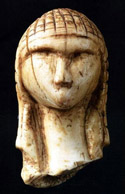Anthropology, Department of

Department of Anthropology: Faculty Publications
Document Type
Article
Date of this Version
2008
Citation
RADIOCARBON, Vol 50, Nr 3, 2008, p 347–357
Abstract
When ancient hearths at open archaeological sites do not yield carbonized annual plant remains or other highquality samples, wood charcoal is commonly used for radiocarbon dating. Sagebrush (Artemisia tridentata Nutt.), a shrub frequently used for fuel across much of the western United States, seems a potentially better candidate for 14C dating than tree wood since the possibility for significant age discrepancy might be less. A comparison of multiple assays from single features reveals that sagebrush can overestimate age more than even tree wood charcoal. A plausible cause of this appears to be persistence of the shrub on the ground surface for an extended interval after death, such that use as fuel almost invariably occurs hundreds of years after fixation of carbon. The potential for age discrepancy may decrease as population density increases because the demand for fuel wood would have resulted in a more rapid turnover of the fuel biomass. This is not true for Archaic period foragers of western North America when population levels were likely quite low and residential mobility quite high.


Comments
© 2008 by the Arizona Board of Regents on behalf of the University of Arizona